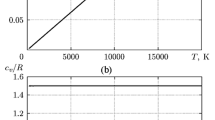An approximate model of chemical equilibrium is formulated for modeling detonation processes in reacting gas mixtures. In comparison with exact (more detailed) models, this model uses additional physical assumptions allowing one not only to expand the scope of its application, but also to significantly simplify the form of the system of equations being solved. It is shown that for adequate (consistent with experiment) calculations of the gas dynamics of detonation flows, it is quite sufficient to describe the components of detonation products by a standard and limited set of substances. A procedure has been proposed to unambiguously determine the molar fractions of these substances in a state of chemical equilibrium, employing only the relative concentrations of atoms such as oxygen, carbon, hydrogen, nitrogen, and any other monatomic inert substances, such as argon.
Similar content being viewed by others
References
V. V. Mitrofanov, Detonation of Homogeneous and Heterogeneous Systems [in Russian], Izd. Inst. Gidrodim. im. M. A. Lavrentieva SO RAN, Novosibirsk (2003).
C. L. Eisen, R. A. Gross, and T. J. Rivlin, Theoretical calculations in gaseous detonation, Vopr. Raketn. Tekh., No. 1, 20–32 (1961).
Yu. A. Nikolaev and M. E. Topchiyan, Calculation of equilibrium flows in detonation waves and gases, Fiz. Goren. Vzryva, 13, No. 3, 393–404 (1977).
A. A. Vasil’ev, A. I. Valishev, V. A. Vasil’ev, L. V. Panfilova, and M. E. Topchiyan, Detonation wave parameters at elevated pressures and temperatures, Khim. Fiz., 16, No. 11, 114–118 (1997).
F. A. Baum, L. P. Orlenko, K. P. Stanyukovich, V. P. Chelyshev, and B. I. Shekhter, Explosion Physics [in Russian], Nauka, Moscow (1975).
A. A. Vasil’ev and V. A. Vasil’ev, Multifuel combustible mixtures: Synthesis gas (CO–H2), J. Eng. Phys. Thermophys., 94, No. 3, 765–774 (2021).
A. A. Vasil’ev and A. V. Pinaev, Formation of carbon clusters in combustion and detonation waves, Fiz. Goren. Vzryva, 44, No. 3, 81–94 (2008).
Yu. A. Nikolaev, A. A. Vasil’ev, and V. Yu. Ul’yanitskii, Gas detonation and its application in engineering and technologies (review), Fiz. Goren. Vzryva, 39, No. 4, 22–54 (2003).
E. S. Prokhorov, Isothermal gaseous detonation model, J. Eng. Phys. Thermophys., 88, No. 3, 730–736 (2015).
E. S. Prokhorov, Approximate model for calculating equilibrium flows of chemically reacting gases, Fiz. Goren. Vzryva, 32, No. 3, 77–85 (1996).
E. S. Prokhorov, Simulation of gas detonation propagation in a medium having variable chemical composition, J. Eng. Phys. Thermophys., 90, No. 1, 151–159 (2017).
I. S. Batraev, A. A. Vasil’ev, V. Yu. Ul’yanitskii, A. A. Shtertser, and D. K. Rybin, Study of gas detonation of overenriched mixtures of hydrocarbons with oxygen, Fiz. Goren. Vzryva, 54, No. 2, 89–97 (2018).
É. R. Pruuél and A. A. Vasil’ev, Equation of state of gas detonation products. Accounting for the formation of condensed phase of carbon, Fiz. Goren. Vzryva, 57, No. 5, 74–85 (2021).
A. A. Shtertser, V. Yu. Ul’yanitskii, I. S. Batraev, S. A. Gromilov, A. V. Okotrub, and A. I. Saprykin, Diagnostics of the structure and composition of ultrafine carbon produced by the detonation method, Zh. Strukt. Khim., 55, No. 5, 1031–1034 (2014).
B. A. Ivanov, Physics of Acetylene Explosion [in Russian], Khimiya, Moscow (1969).
E. S. Prokhorov, Melting temperature of carbon particles behind the gaseous detonation front, Sib. Fiz. Zh., 16, No. 2, 59–70 (2021).
E. S. Prokhorov, Toward calculation of equilibrium states of hydrocarbon combustion products with a lack of oxygen, Sib. Fiz. Zh., 14, No. 4, 74–81 (2019).
V. P. Glushko (Ed.), Thermodynamic and Thermophysical Properties of Combustion Products, Handbook [in Russian], Vol. 3, VINITI, Moscow (1973).
V. P. Glushko (Ed.), Thermodynamic Properties of Individual Substances, Reference book in 4 vols. [in Russian], Nauka, Moscow (1978).
S. K. Godunov, A. V. Zabrodin, M. Ya. Ivanov, A. N. Kraiko, and G. P. Prokopov, Numerical Solution of Multidimensional Problems of Gas Dynamics [in Russian], Nauka, Moscow (1976).
Author information
Authors and Affiliations
Corresponding author
Additional information
Translated from Inzhenerno-Fizicheskii Zhurnal, Vol. 96, No. 3, pp. 671–681, May–June, 2023.
Rights and permissions
Springer Nature or its licensor (e.g. a society or other partner) holds exclusive rights to this article under a publishing agreement with the author(s) or other rightsholder(s); author self-archiving of the accepted manuscript version of this article is solely governed by the terms of such publishing agreement and applicable law.
About this article
Cite this article
Prokhorov, E.S. Unified Approach to Modeling Equilibrium Flows of Detonating Gases. J Eng Phys Thermophy 96, 669–677 (2023). https://doi.org/10.1007/s10891-023-02728-7
Received:
Published:
Issue Date:
DOI: https://doi.org/10.1007/s10891-023-02728-7




